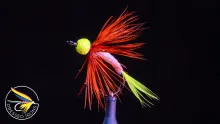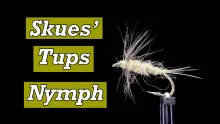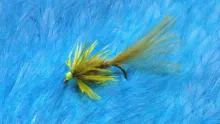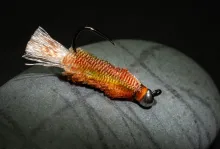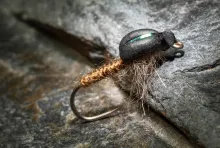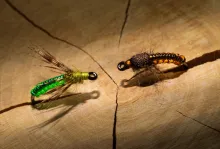Sight fishing for grayling in the clear mountain rivers of Slovakia.
Sight fishing is undoubtedly one of the most interesting and most fun fly fishing tactics in the world of fly fishing. Searching and spotting the fish in its natural habitat makes this activity very demanding on the one hand. On the other hand its successful realization is the most memorable fly fishing experience.
Sight fishing in fresh waters is in most cases associates with fly fishing for big trout, especially brown trout. This is not surprising at all. Clear fresh waters of Europe, America and New Zealand are the typical habitats for trout.
There aren't so many rivers in Europe, which are suitable for sight fishing.
Sight fishing paradise
The sight fishing paradise is without doubt New Zealand.
I was blessed with the opportunity of spending a few European winters on the South Island of New Zealand, sight fishing for the biggest trout on earth.
It took me quite a long time to get used to this, for me as European fly fisherman, before then unknown fly fishing tactic. Once I mastered all necessary aspects of this unique technique, it became my favorite fly fishing strategy.
Sight fly fishing is like hunting. You have to find and spot the fish before the fish notices you. If the fish gets scared, it swims away or stops feeding. Spotting the fish in its natural habitat can be very difficult because of its perfect camouflage. You have to train your sight to be able to distinguish what is fish and what is not. A few times I had fun trying to catch a big stone or a log, thinking it was a big brown trout.
Perfect casting with a dry fly or a nymph is also needed to be successful.
I missed the entertainment
Every time I came back from New Zealand to my home country of Slovakia I missed this entertaining fly fishing method. So I thought to myself, what if I use the entire sight fly fishing experience from New Zealand and try it on the Slovakian mountain rivers?
I knew it would not be easy to find optimal conditions for this fly fishing strategy, but after few search expeditions in the Slovak Natural parks, I was lucky ti find a few unique rivers, which made it possible to try sight fishing here in Slovakia.
While I was searching, I focused on small highland rivers with clear and shallow water, where it would be possible to spot even a smaller trout.
The grayling surprise
The biggest surprise was when I spotted nice graylings instead of brown trout. My assumption that there would be only brown trout up in the mountains was wrong.
For me as a big grayling fan, two dreams came true. The first one was the sight fly fishing on my homeland rivers, and the second was the dream of big graylings in small mountain rivers. These mountain rivers are a true grayling paradise. Although quit small and shallow they hold plenty of big and healthy fish. So my strategy was almost the same as in New Zealand, but instead of big brown trout, grayling was the target fish.
Everyone who once saw a grayling knows how perfect its camouflage is. Observing them in shallow waters feeding on nymphs or standing close to the surface waiting looking for insects is an unforgettable experience.
An indispensable part of the equipment is polaroid sunglasses, which allows you better vision in the water. Without them, it would be almost impossible to spot a grayling. Sunshine also makes the spotting easier.
Fly fishing gear
I prefer a fine short rod with fast action for precise casting of both nymphs and dry flies. I use a floating fly line and a strike indicator on the leader for exact recognition of fine the grayling takes.
My favorite rod is 6,6 feet for a 4 weight line with a fast action. It's very short, but a perfect rod for the small mountain rivers. It enables you to cast precisely under sometimes very hard conditions close to the river bank and vegetation.
The leader is 0.16 or 0.14 mm even down to 0.12 mm (5X-6X-7X) fluorocarbon depending on the water condition and the flies. The leader length is about 2 meters or about 6 feet. For grayling you don't have to use very long leaders like for trout. This makes casting much easier.
Typical nymphs: Imitations of mayfly and caddis larvae like a Pheasant Tail on hook size 16 and 18 or a Hare's Ear Nymph on 14 and 16.
Typical dry flies: CDC imago and dun imitations on hook size 16 or 18 or Caddis imitations with deer or elk hair on hook size 14 and 16.
Fly fishing strategy
I always wade gently upstream trying not to spook the fish or make the grayling suspicious. Once I spot a grayling, I try to observe his behavior to find out if he is feeding or resting. Resting and unmoving fish are unlike to attack your fly.
In most cases, the grayling is feeding on underwater insects, so you have to use nymphs. My favorite imitations are the small dun larvae known as micro nymphs tied on hook size 18 or smaller.
A good thing about grayling is that you don't have to cast so far as for brown trout, if you manage to come close enough without spooking it. Grayling is also more forgiving to false casts or multiple casting tries. But the rule is still the same: the fewer and more precise casts, the bigger the chance of catching the spotted fish.
For dry flies as well as for nymphs, the grayling need some time to observe and inspect the floating food, so the presentation of the fly should be as natural as possible and the cast should place the fly at least 1,5 meter above the feeding grayling - depending on depth and speed of the water.
Striking and fighting
Correct striking technique is essential. Grayling take the fly pretty fast, and when it notices that it's an artificial bait, it spites it out even faster. So the reaction of the fly fisherman must be as fast as possible after the strike indicator moves or disappears under water or the dry fly has been sucked down by a grayling.
Fighting grayling in small mountain rivers can be a great adventure, especially by bigger specimens. They like to jump out of water and their muscular body with the massive dorsal makes them a perfect fighting machine.
Even though it's very demanding on wading, spotting, casting and keeping focus, once you have mastered this techniques, it gives you that great feeling of having accomplished something very special.
This is how sight fishing for grayling became my favorite fly fishing activity in my beautiful home country of Slovakia.
For more information about fly fishing in Slovakia visit www.flyfishing-slovakia.com.
Andrej Polcic
- Log in to post comments



















